The Coagulation Process in Water Treatment
Water treatment is an essential process that makes water safe for human consumption and various industrial applications. Among the various techniques used in water purification, coagulation plays a crucial role. This article explores the principles of coagulation, its importance, and the methods employed in water treatment facilities.
Understanding Coagulation
Coagulation is the process where fine particles suspended in water aggregate to form larger particles known as flocs. This is particularly important because the small particles, which can include dirt, algae, bacteria, and other contaminants, are often too tiny to be removed by simple filtration methods. The process involves the addition of coagulants—chemical substances that facilitate the aggregation of these disbursed particles.
How Coagulation Works
The coagulation process typically involves several steps
1. Coagulant Addition A coagulant, such as aluminum sulfate or ferric chloride, is added to the water. These coagulants are positively charged and neutralize the negative charges on the particles suspended in water, allowing them to come together.
2. Rapid Mixing After the coagulant is added, the water is rapidly mixed to ensure that the coagulant is evenly distributed and that the particles can interact more effectively.
3. Flocculation Following rapid mixing, the water undergoes slow mixing or flocculation, which allows the particles to collide and form larger aggregates, or flocs. This step is critical as it helps to enhance the size and settling rate of the particles.
coagulation process in water treatment pdf

4. Sedimentation Once flocs have formed, the water is allowed to sit in a sedimentation basin. The larger flocs settle to the bottom due to gravity, separating from the clear water above.
5. Filtration After sedimentation, the clearer water is then filtered to remove any remaining particles and floc. This step may involve different filtration methods, including sand filters or membrane filtration.
6. Disinfection Finally, the treated water is disinfected, usually by adding chlorine or using ultraviolet (UV) light, to eliminate any remaining pathogens before it is distributed for public use.
Importance of Coagulation in Water Treatment
The coagulation process is vital for several reasons
- Enhanced Water Quality Coagulation significantly improves water quality by removing particulate matter, color, and turbidity, contributing to cleaner drinking water. - Cost-Effective Coagulation is a cost-effective method for treating large volumes of water, making it a staple in municipal water treatment plants.
- Prevention of Problems By removing organic and inorganic particles, coagulation helps prevent corrosion, scaling in pipes, and the growth of biofilms, thereby extending the lifespan of water infrastructure.
Conclusion
Coagulation is a fundamental process in water treatment that ensures the removal of harmful contaminants from water supplies. By transforming small, suspended particles into larger flocs that can be easily removed, coagulation plays a critical role in enhancing water quality and ensuring public health. As water treatment technology continues to evolve, the principles of coagulation remain central to effective water purification practices, highlighting its enduring importance in safeguarding our most vital resource—water.

